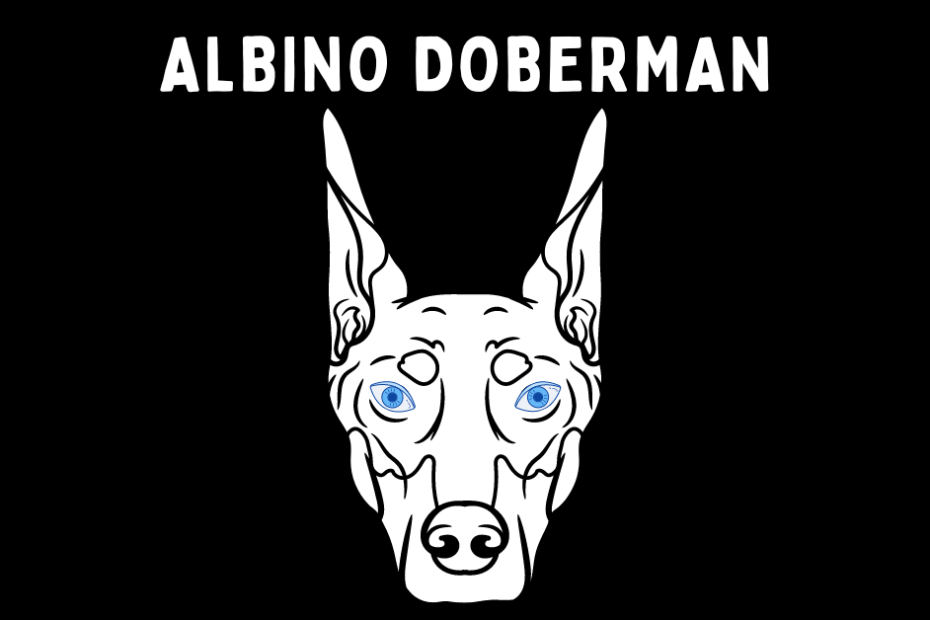Dobermans are black and rust (or reddish) – everyone knows that…
Sure, Dobermans have other standard breed colors as well. But in the 1980s, a new “color” popped up.
This color has never been seen before in Dobermans. In fact, it’s rarely been seen in any dogs before.
The albino Doberman sent a shock to the Doberman community and the dog world. Breeders and owners still need help getting their facts straight regarding the albino Doberman.
In this article, I will tell you the whole story of the albino Doberman. Also, I will answer all the common questions regarding the albino Doberman.
What is an Albino Doberman?
The albino Doberman is a rare instance in which a Doberman has albinism genetics. This condition often gives the dog light pink skin, semi-white or translucent color, and blue or red eyes.
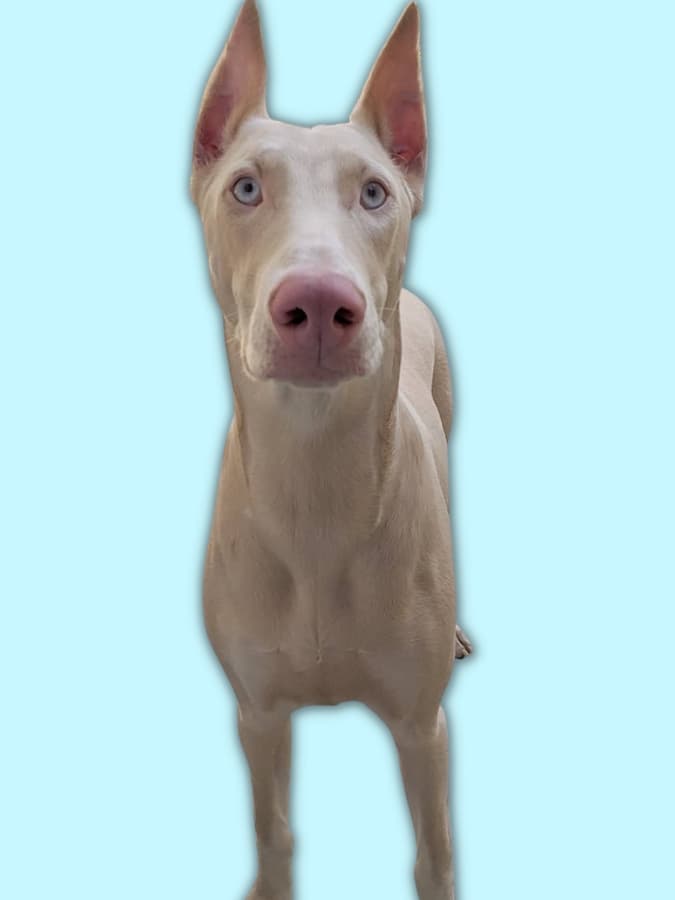
As with many breeds, Doberman Pinschers, including a few white dogs, come in many colors. However, the breed also has instances of albinism. There are albino Doberman Pinschers and colored Dobermans who carry albinism genetics.
Carriers can pass those genetics onto the next generation of puppies.
Compared to white, albinism often refers to the animal’s inability to create color or only minimal color in the coat and eyes. In many species, albinism can lead to eyesight, hearing, and temperament issues.
Albinism in dogs
But what exactly is albinism, and what qualifies as an albino Doberman compared to a white Doberman? What do they look like, and what causes albinism? When did albinism start to appear in the Doberman breed, and does it cause problems to the dog’s health?
Because albinism typically comes from a mutation and can lead to significant health problems, it’s worth taking a solid look at the health and colors found in the ancestry of an albino Doberman and having an independent veterinarian look the puppy or dog over before committing to a purchase.
This ensures that you won’t have any unpleasant and expensive surprises down the road.
In this article, you’ll find a solid explanation of where albinism came from in the Doberman Pinscher breed and how it can impact the animals’ health and well-being. We’ll also look at all the aspects of this fascinating breed mentioned in the first paragraph.
General appearance of the Doberman breed
The Doberman breed has four recognized colors:
- black and rust,
- red and rust,
- blue and rust,
- and fawn and rust.

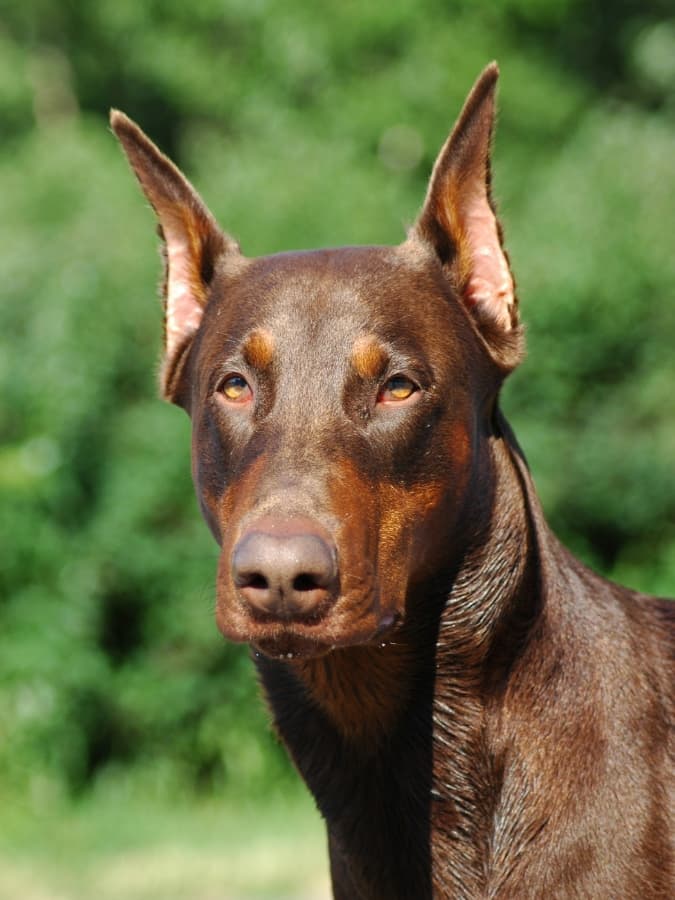
Because rust is expected as part of the markings for all four Doberman colors, many dog breeders refer to the colors as black, red, blue, and fawn, with the rust, assumed.
Black and red are deeper, richer colors, while blue and fawn occur because the dog has the dilute gene from both parents to lighten the expression of the color in the coat.
They are between 24-28″ at the withers, with an equal length from the fore chest to the upper thigh’s rear projection, and are of medium size with a squared body appearance that is in proportion.
They are compact, muscular, and powerful, capable of great endurance and speed. Dobermans are excellent guard dogs.
They have a proud carriage and noble appearance, with a tendency towards watchfulness, alertness, loyalty, obedience, fearlessness, determination, and high energy.
What do albino Dobermans look like?
As a non-standard breed color, albino Dobermans have a light coat and are referred to as white Dobermans due to breeders not always having a full grasp of the complexity of albino genetics.

The dogs otherwise will often have an appearance and conformation similar to most other Dobermans.
Because albinism comes from a genetic mutation, which started with one particular albino Doberman, Padula’s Queen Sheba, her lineage and offspring have become a source of study for those interested in the albino Doberman.
All albino Doberman dogs today are bred from her offspring. As a double-recessive condition, her sire, Rasputin VI, and dam, Dynamo Humm, who were black and rust, would have had to have been carriers of the gene.
As a reminder, a recessive gene is concealed when a dominant gene is present.
If the color was caused in this fashion, which would be suggested by the birth of a “white” Doberman from another litter of the same pairing.
Coat color
Though albino Doberman Pinschers have white hair in their coats, as do white Dobermans, their hair has a smaller size, shape, and number of pigment granules, along with a finer hair diameter.
This gives it a more translucent quality. This quality is best seen under a microscope, where the individual cells in the hair can be seen and studied.
This quality often allows the dog’s pink skin to make the hair appear pale pink, but if the hair is removed from the dog, its base translucent white color becomes more obvious.
The tone can also appear as a silvery fawn depending on the exact genetics.
Blue eyes
Queen Sheba was born with blue eyes, and further study of photos, hair samples, films, and similar evidence point to her being a tyrosine-positive albino.
Tyrosine allows a small amount of coloration to occur in the animal, giving it pale blue eyes that will have a red tint in bright light.
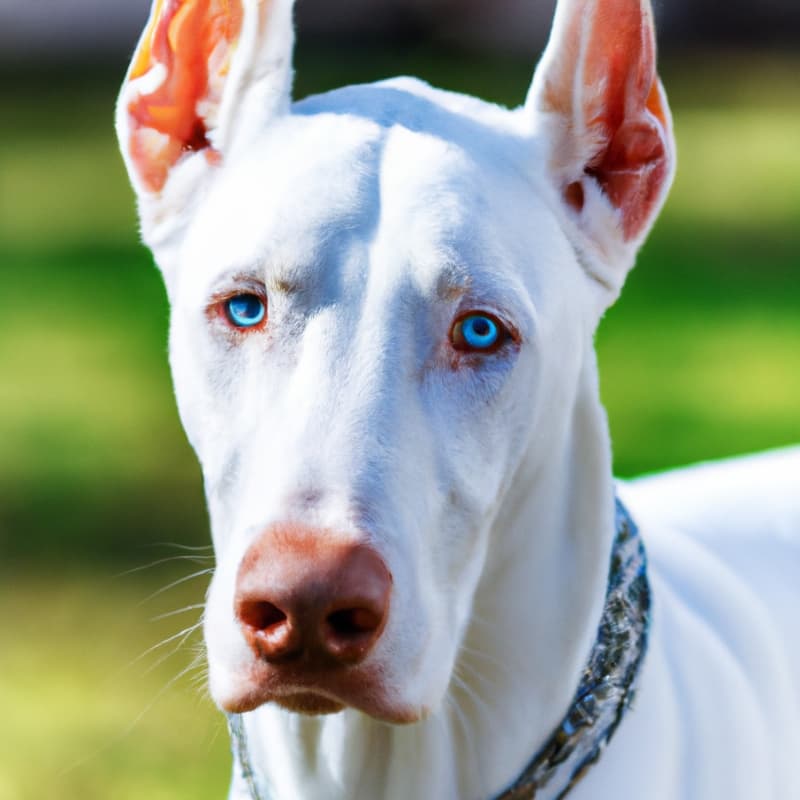
By comparison, tyrosine-negative albinism, such as that seen in laboratory animals, only produces pink or red eyes completely lacking in pigment.
Because Queen Sheba is the common ancestor to all albino Doberman Pinschers today, the breed only has tyrosine-positive albinism, meaning all albino Doberman dogs have pale blue eyes.
However, given the genetic mutation that made Sheba a tyrosine-positive albino, it’s not impossible for another mutated gene to create a tyrosine-negative albino, which would have pink or red eyes.
That being said, given that Sheba’s litter by her son Tar-Zan and the only two puppies that survived were tyrosine-positive albinos, there remains the possibility that tyrosine-negative albino Doberman dogs are, in fact, a type of fatal white.
Which means they could not survive outside of the womb. However, further study is needed on the topic.
Now let’s take a deep dive into what causes albinism in general and specifically in Dobermans.
What causes albinism in Dobermans?
Albinism is caused by a lack of melanin pigment and further lack of pigment in animals that do not produce tyrosine. If you picture the standard laboratory animal, all white with pink skin and pink or red eyes, you understand what a tyrosine-negative albino animal looks like.
However, this lack of pigment is recessive because white animals stand out in the wild and often do not reach reproductive age before being killed by prey species.
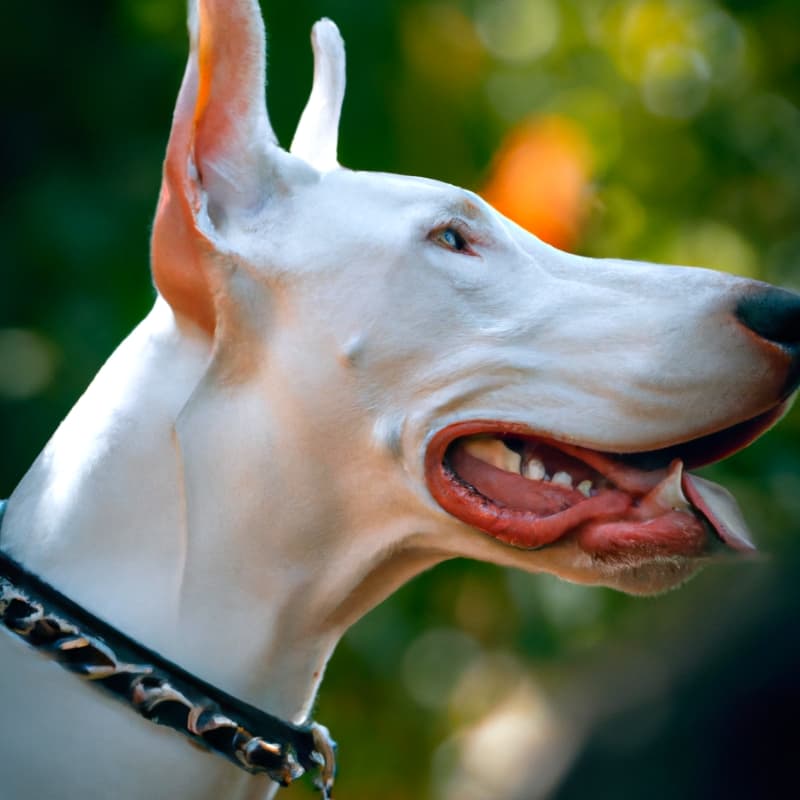
The exception to this are animals found in tundra and arctic conditions.
Even in those circumstances, white or cream animals with some pigment on the foot pads, eyes, and nose are more likely to live longer because of superior eyesight and hearing combined with lower chances of skin cancers.
However, in modern breeding practices, albinism is becoming more common. This is partially because domesticated albino animals are protected by the humans that own them from predation and lack of veterinary care.
This does not reduce the potential issues regarding the animal’s health, only that they are more likely to survive to breeding age, whether they should be bred or not for the good of the species or breed.
In some cases, such as paint horses, albinism can present as white markings on an otherwise-colored horse, including a pale blue eye or eyes if the albino markings pass over the eye socket.
In Doberman Pinschers, the albino mutation was very rare and recessive.
The fact that in all of the breed’s history, there had been only one albino registered between the Doberman Pinscher Club of America’s founding in 1921 and Sheba’s birth on November 10, 1976, displays this rarity.
This span of 55 years points to very rare genetics in purebred Dobermans.
In Doberman Pinschers, because the genetics for albinism is so rare, registered non-standard albinos must come from her lineage. This process has required some level of line breeding to continue to bring out the albino traits.
This practice was started with Sheba, who was bred to a black male. Two black puppies were retained when Sheba produced her litter: Padula’s Tar-Zan and Padula’s Princess.
Princess was bred back to her sire, producing two white females as well as black-and-tan puppies, while Sheba was bred to Tar-Zan, producing two albino males, which were the only puppies that survived.
Though Sheba had a “white coat” brother, he was struck by a car at five months of age, preventing his genetics from being studied and his genes from being passed on.
Studies of albinism in Sheba’s progeny, including genetic testing, point to a partial deletion of SLC45A2. This deletion causes what is referred to as oculocutaneous albinism in the Doberman breed specifically.
It is presumed to be the mutation in Sheba and the “white” male produced from the same pairing.
Albino Doberman History
So, once upon a time, there was a cute little puppy named Padula’s Queen Sheba, who happened to be an albino Doberman Pinscher.
This was a big deal because no one thought albino Dobermans could exist in purebred stock…But little Sheba proved them all wrong and rocked the Doberman world to its foundation.
Check out the full story below.
Padula’s Queen Sheba
As the first albino Doberman Pinscher registered, Padula’s Queen Sheba rocked the Doberman world to its foundation.
Before this point, it wasn’t believed that albino Dobermans could possibly exist in purebred stock because there had been no instances in the many decades since the breed club was founded.
She was born to a litter of 12, including seven females and five males. In prior breeding of Dynamo Humm and Rasputin VI, a “white” or albino male puppy was born in a litter of unknown size and composition.
Two additional breeding of Dynamo Humm with other sires did not produce any albino Doberman puppies.
The breeder, Mrs. Ray Potter, only registered Sheba, feeling that the rest of the litters needed to be of better quality to make registration worthwhile or that they did not otherwise meet the breed standard.
The white male was struck by a car at five months, while Mrs. Potter took Sheba and a black male littermate to Norfolk, Virginia, where she stayed to be near her son, who was in the Navy.
While there, she advertised the puppies in the paper. The black dog was purchased and disappeared from monitoring.
Julia Schulz initially purchased Sheba. She was sold again due to a dominance and fighting issue with another dam she was breeding.
Joe Padula purchased Sheba and finally registered her on January 24, 1979, anticipating her first litter born on April 24 of the same year.
He filled in albino as the color, which brought Sheba to the attention of the American Kennel Club, who replied that albino was not a color and that he should send in photographs of Sheba.
After reviewing the photos, the AKC registered Sheba as a white Doberman Pinscher, the breed’s first dog of that color.
American Kennel Club
Given the wide range of dog breeds that the AKC deals with daily, the conclusion that Sheba was a white Doberman is perhaps understandable. However, the organization did have the opportunity to contact the Doberman Pinscher Club of America for clarification and advice on the new color.
Because it did not do so, white Dobermans became a precedent, leading to much confusion as to whether the dogs were albino or white. As it happens, they are the same.
After much debate, the American Kennel Club no longer recognizes white Doberman Pinschers, including albino Doberman dogs, as meeting the breed’s standard.
The AKC breed standard includes black and rust, blue and rust, red and rust, and fawn (Isabella) and rust.
This was done after the first white Doberman, Sheba was registered without consulting with the parent association for the breed.
According to Doberman-Chat, a Doberman that a “Z” in their AKC registration number has an ancestor with albino genetics [1]doberman-chat.com.
Doberman Pinscher Club of America
A couple of years after Sheba was registered with the AKC, several active members of the Doberman Pinscher Club of America studied her and her offspring to determine where, if anywhere, an albino Doberman should fall in the breed standard.
Working with early geneticists, the “White” Doberman Research Committee was formed to answer the many questions about these dogs.
Provided with opportunities to research these dogs, they were provided with semen samples, funds for purchasing white Dobermans, whether breeding should be encouraged or discouraged, breeding records, and similar information.
The organization funded a five-year breeding study with the assistance of Dr. John Paul Scott of Bowling Green State University in Kentucky.
In a time before a DNA test was standard, breeding studies were used to determine whether the cause was a true albino mutation or just an extreme dilution of color in the dog, which would show up differently in litters and allow the gene to be identified.
Two dams were purchased from Mr. Padula, one Dondo, a dirty grey shade, and one Cornaz, a sandy shade. The shades in white Dobermans would vary based on climate and sunlight exposure.
What’s the difference between a white Doberman and an albino Doberman?
Though some breeds have white and albino coloration, this is not so with the Doberman Pinscher breed.
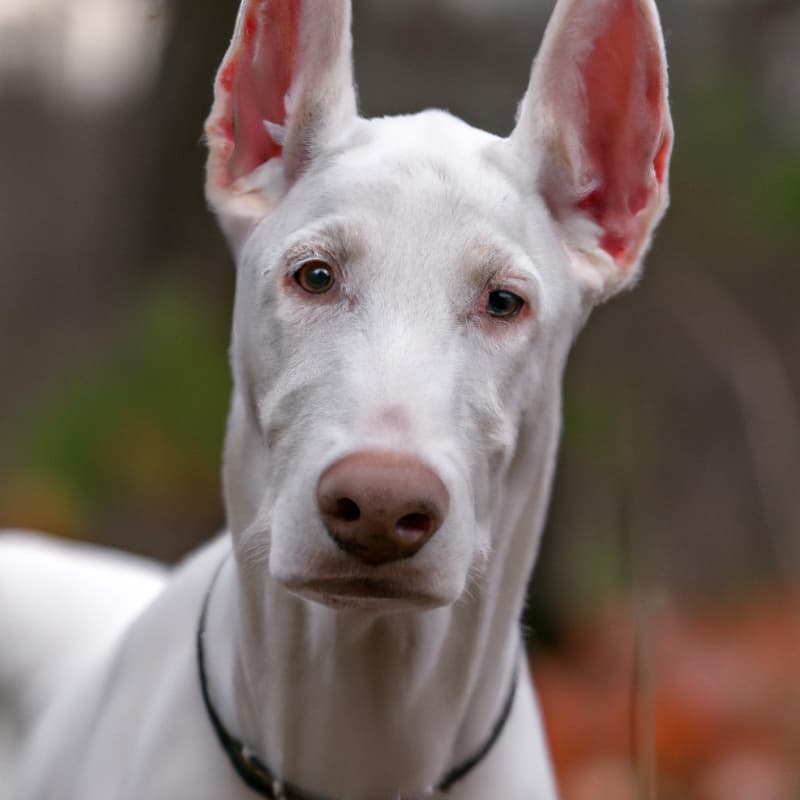
In some breeds, you may have a white or cream dog, which may have dark or pink noses, lips, and paw pads, as well as dogs with albinism which have pink or blue eyes with a pink nose, lips, and paw pads.
However, due to the extreme rarity of albino mutations in the Doberman breed, for the purposes of breed registration, there are currently only white Dobermans, which are not fully albino.
Is a white Doberman albino?
No, if you’re speaking about a tyrosine-negative true albino, where the dog produces absolutely no pigment whatsoever.
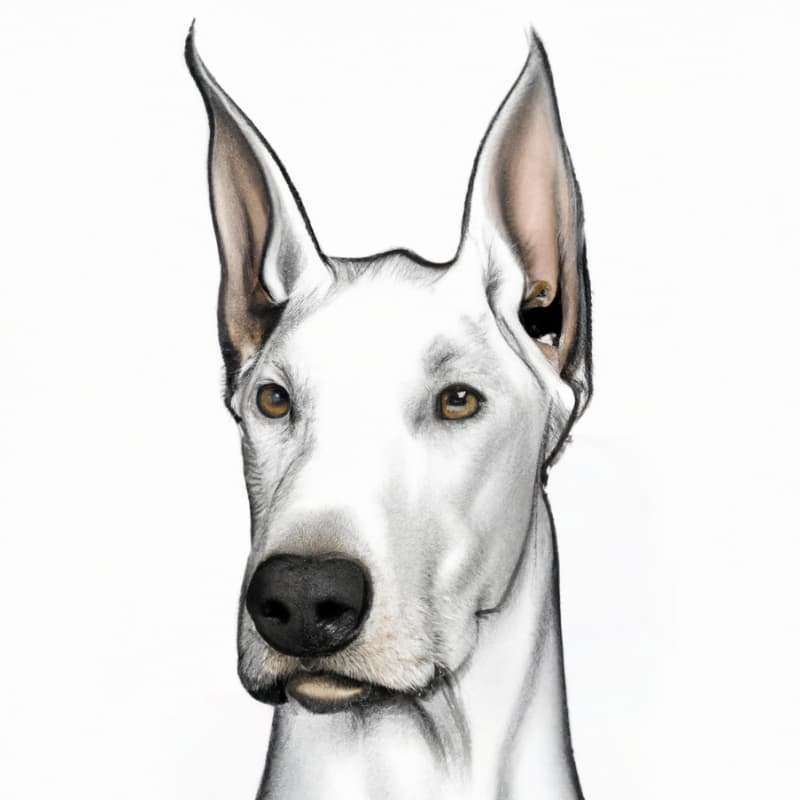
Technically speaking, white Dobermans are tyrosine-positive albino dogs, meaning they have some small pigment to color their eyes blue, but not terribly much.
However, because they produce this small amount of pigment, they are not considered true albino Dobermans by many in the industry and are instead referred to simply as white Dobermans.
White Dobermans are often mistaken for true albinos.
Health issues of albino Dobermans
As was mentioned above, there are some concerns about albino animals in general. But what kind of health issues can impact an albino Doberman?
Albino Dobermans risk of skin cancer
Because of the combination of very short, fine hair and very pale skin, albino Dobermans are susceptible to sunburn and a variety of skin cancers and skin tumors from excess sun exposure.
This may be why they tend to shun the outdoors, especially on bright days, combined with the potential for eyesight issues. For this reason, it’s essential to ensure that an albino Doberman Pinscher has ready access to deep shade and limit their exposure to bright sunlight.
How much is an albino Doberman?
Albino Dobermans are still being bred from Sheba’s lines, but as with any specialty coat or animal, you can expect to pay a significant premium for this type of dog.
However, given the specific rarity of albino Doberman Pinschers due to the SLC45A2 mutation, the premium is even higher than it would be for albino puppies in other breeds, where this type of mutation may be significantly more common.
Generally speaking, depending on the amount of work the breeder undertakes before pickup or shipping, these dogs often range from $800 to $2,500.
Can you breed albino Dobermans?
Generally speaking, it isn’t dangerous to breed albino Dobermans per se, but it can be unethical. Because of the variety of health issues that they may have, only experienced breeders who understand the complex genetics that can lead to albino Doberman Pinschers should attempt to breed these dogs.

However, breeding an albino Doberman to a Doberman of a different color, especially one that does not have the albino recessive genetics, the puppies who are born should do better at avoiding the related health issues, though they will probably not have the related pale eyes and coat color.
If this type of breeding is undertaken, the new owner of any puppies should be made aware of their status as albino carriers and the risks of producing albino puppies.
As always, you must be extremely confident you are dealing with a responsible breeder.
Are albino Dobermans blind?
Technically speaking, albino Doberman Pinschers are not usually blind but are often very light-sensitive.
Upon receiving the two dams from Mr. Padula, the “White” Doberman committee witnessed the dogs rush from their crates, somewhat traumatized by their flight experience, and then run directly into a fence.
When observed, it was noted that it had not happened because the dogs were blind, as initially assumed, but their eyes were tightly shut against the bright sunlight. Films of the related albino Doberman Pinschers showed that many dogs were squinting in bright light, confirming this observation.
This was in line with Mr. Padula’s observation that the dogs were more active during the early morning and evening.
However, Mr. Padula’s observation was based on the heat of the day, and he had not noticed that the dogs were particularly photosensitive, thinking that they enjoyed the cooler temperatures.
It was also noted by observers watching Sheba, the origin of the albino gene in the breed, that in Mr. Padula’s ceramic shop, she was very tentative in navigating the shop, especially its narrow doorways and hallways.
It was believed this was due to a deficit in her vision, though she was not entirely blind.
Are there any other issues that are typical to albino Dobermans?
In addition to issues with eyesight, there may be some issues with hearing, as the same observers felt that the amount of noise needed to get the dogs’ attention for photos was excessive.
One individual believed that the dogs may have eventually been able to feel the vibrations from the noise, though there was evidence of some poor hearing.
Other owners, however, have mentioned that they have had no issues with their albino Doberman responding quickly and accurately to audible commands, which may point to some issue with the specific dogs being photographed or personality traits that led the canines to ignore the human trying to photograph them.
Some individuals feel that the albino Doberman may have some tendencies toward fear snapping, but this may also be due to poor sensory perception or fear of a new environment.
Only in observing the specific Doberman can one determine whether this may be an issue of temperament or simply a fear response to a new setting.
Anecdotal evidence may point to a tendency towards snappishness, but this has not been borne out through scientific testing.
However, given the breed’s tendency towards protection, the animals in question protected one individual in a household from another who was deemed a threat for unknown reasons.

References
| ↑1 | doberman-chat.com |
|---|

